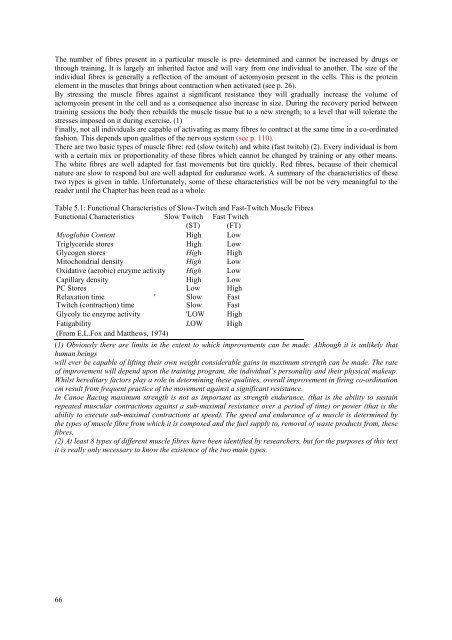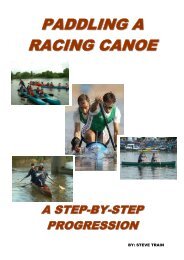The Science of Canoeing By Richard Cox
The Science of Canoeing By Richard Cox
The Science of Canoeing By Richard Cox
Create successful ePaper yourself
Turn your PDF publications into a flip-book with our unique Google optimized e-Paper software.
<strong>The</strong> number <strong>of</strong> fibres present in a particular muscle is pre- determined and cannot be increased by drugs or<br />
through training. It is largely an inherited factor and will vary from one individual to another. <strong>The</strong> size <strong>of</strong> the<br />
individual fibres is generally a reflection <strong>of</strong> the amount <strong>of</strong> actomyosin present in the cells. This is the protein<br />
element in the muscles that brings about contraction when activated (see p. 26).<br />
<strong>By</strong> stressing the muscle fibres against a significant resistance they will gradually increase the volume <strong>of</strong><br />
actomyosin present in the cell and as a consequence also increase in size. During the recovery period between<br />
training sessions the body then rebuilds the muscle tissue but to a new strength; to a level that will tolerate the<br />
stresses imposed on it during exercise. (1)<br />
Finally, not all individuals are capable <strong>of</strong> activating as many fibres to contract at the same time in a co-ordinated<br />
fashion. This depends upon qualities <strong>of</strong> the nervous system (see p. 110).<br />
<strong>The</strong>re are two basic types <strong>of</strong> muscle fibre: red (slow twitch) and white (fast twitch) (2). Every individual is born<br />
with a certain mix or proportionality <strong>of</strong> these fibres which cannot be changed by training or any other means.<br />
<strong>The</strong> white fibres are well adapted for fast movements but tire quickly. Red fibres, because <strong>of</strong> their chemical<br />
nature are slow to respond but are well adapted for endurance work. A summary <strong>of</strong> the characteristics <strong>of</strong> these<br />
two types is given in table. Unfortunately, some <strong>of</strong> these characteristics will be not be very meaningful to the<br />
reader until the Chapter has been read as a whole.<br />
Table 5.1: Functional Characteristics <strong>of</strong> Slow-Twitch and Fast-Twitch Muscle Fibres<br />
Functional Characteristics Slow Twitch Fast Twitch<br />
(ST) (FT)<br />
Myoglobin Content High Low<br />
Triglyceride stores High Low<br />
Glycogen stores High High<br />
Mitochondrial density High Low<br />
Oxidative (aerobic) enzyme activity High Low<br />
Capillary density High Low<br />
PC Stores Low High<br />
Relaxation time ' Slow Fast<br />
Twitch (contraction) time Slow Fast<br />
Glycoly tic enzyme activity 'LOW High<br />
Fatigability<br />
(From E.L.Fox and Matthews, 1974)<br />
LOW High<br />
(1) Obviously there are limits in the extent to which improvements can be made. Although it is unlikely that<br />
human beings<br />
will ever be capable <strong>of</strong> lifting their own weight considerable gains in maximum strength can be made. <strong>The</strong> rate<br />
<strong>of</strong> improvement will depend upon the training program, the individual’s personality and their physical makeup.<br />
Whilst hereditary factors play a role in determining these qualities, overall improvement in firing co-ordination<br />
cm result from frequent practice <strong>of</strong> the movement against a significant resistance.<br />
In Canoe Racing maximum strength is not as important as strength endurance, (that is the ability to sustain<br />
repeated muscular contractions against a sub-maximal resistance over a period <strong>of</strong> time) or power (that is the<br />
ability to execute sub-maximal contractions at speed). <strong>The</strong> speed and endurance <strong>of</strong> a muscle is determined by<br />
the types <strong>of</strong> muscle fibre from which it is composed and the fuel supply to, removal <strong>of</strong> waste products from, these<br />
fibres.<br />
(2) At least 8 types <strong>of</strong> different muscle fibres have been identified by researchers, but for the purposes <strong>of</strong> this text<br />
it is really only necessary to know the existence <strong>of</strong> the two main types.<br />
66



